Get a Customized Website SEO Audit and Online Marketing Strategy and Action
The Pareto Principle is relatively straightforward but crucial. It bears the name of the Italian economist Vilfredo Pareto, who discovered in 1906 that 20% of the people in Italy controlled 80% of the country’s land.
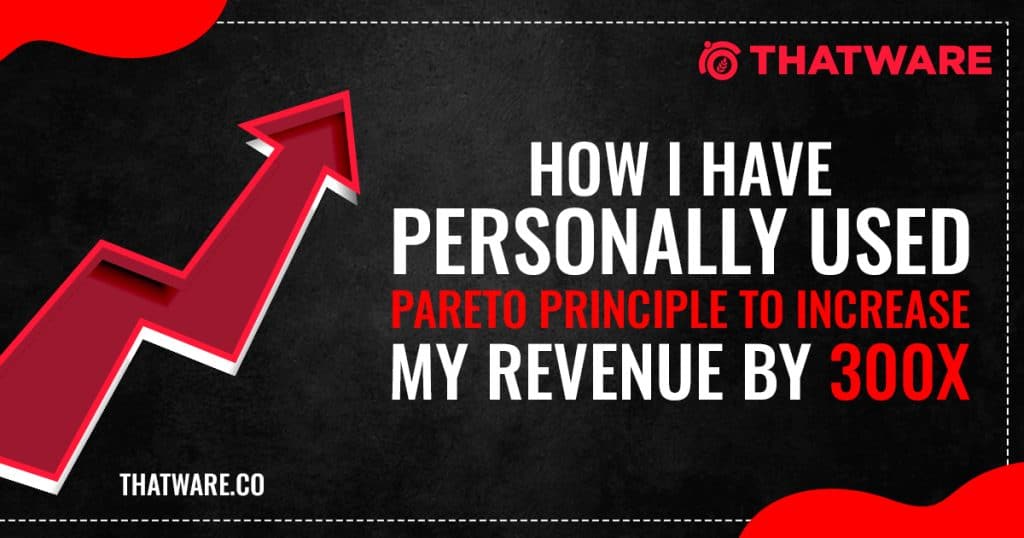
The most significant aspect of Pareto’s discovery was how frequently this 80/20 distribution occurred. For instance, 80% of your sales, on average, come from 20% of your consumers. And 80% of your outcomes come from 20% of your time, and so on.
The Pareto Principle, sometimes known as the “80/20 Rule” in modern parlance, is a powerful strategy for expanding your company. For instance, you may spend more time on some tasks and less time on others if you can identify the 20% of your time that results in 80% of the benefits for your organization. Similarly, you may locate additional consumers with the traits of your top 20% of customers, who account for 80% of your sales, significantly increasing your sales and earnings.
So How Did I Use Pareto Principle?
Currently, the entire workforce of my company is divided into 8 teams. Each team is represented by a Team Lead, Graphic Designers, Content Writers, Developers, SEO executives and Link Builders.
Each team is then designated an “n” number of projects as per onboarding.
Currently, the hierarchy is as follows –
Team 1
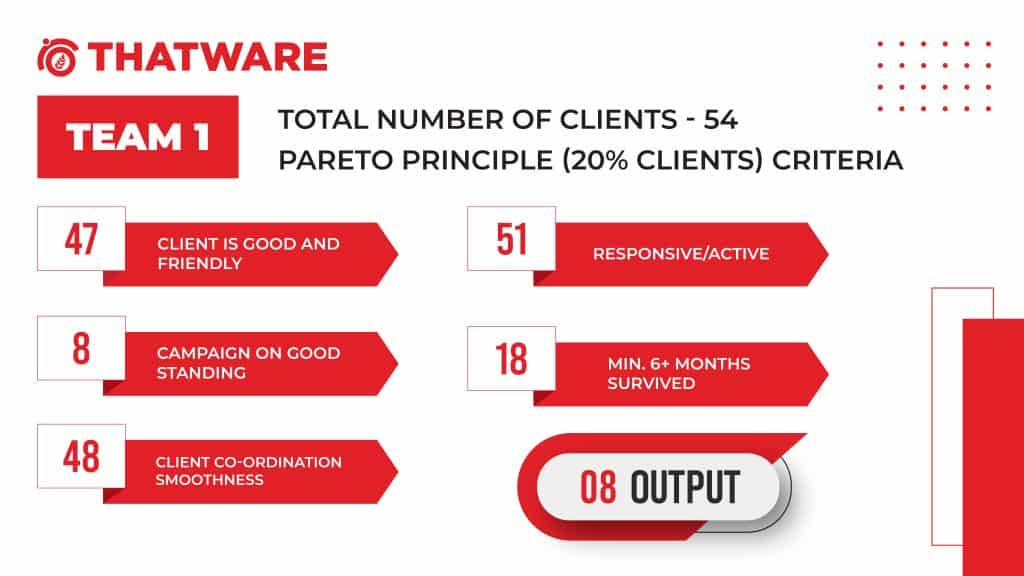
Team 2

Team 3
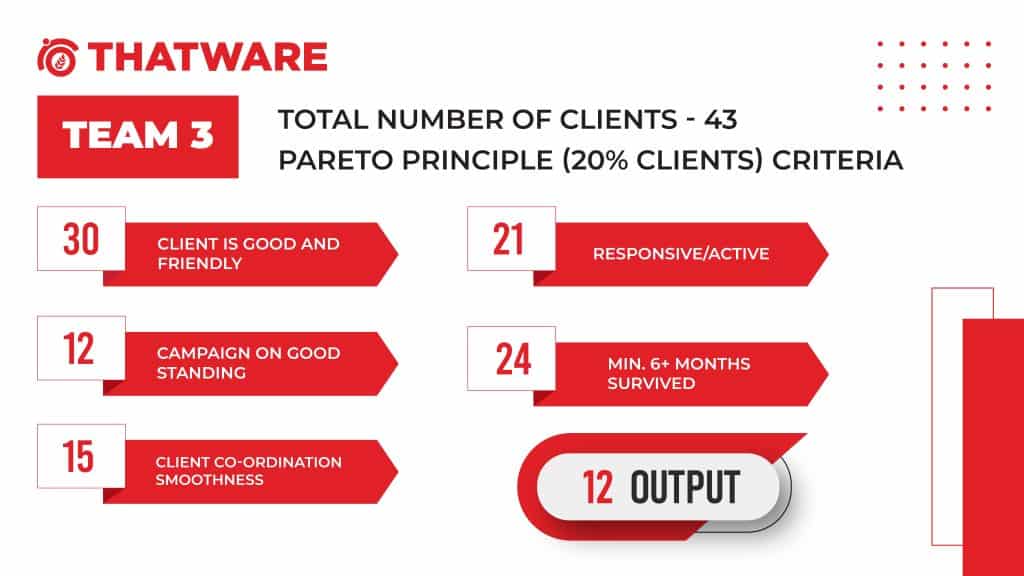
Team 4

Team 5
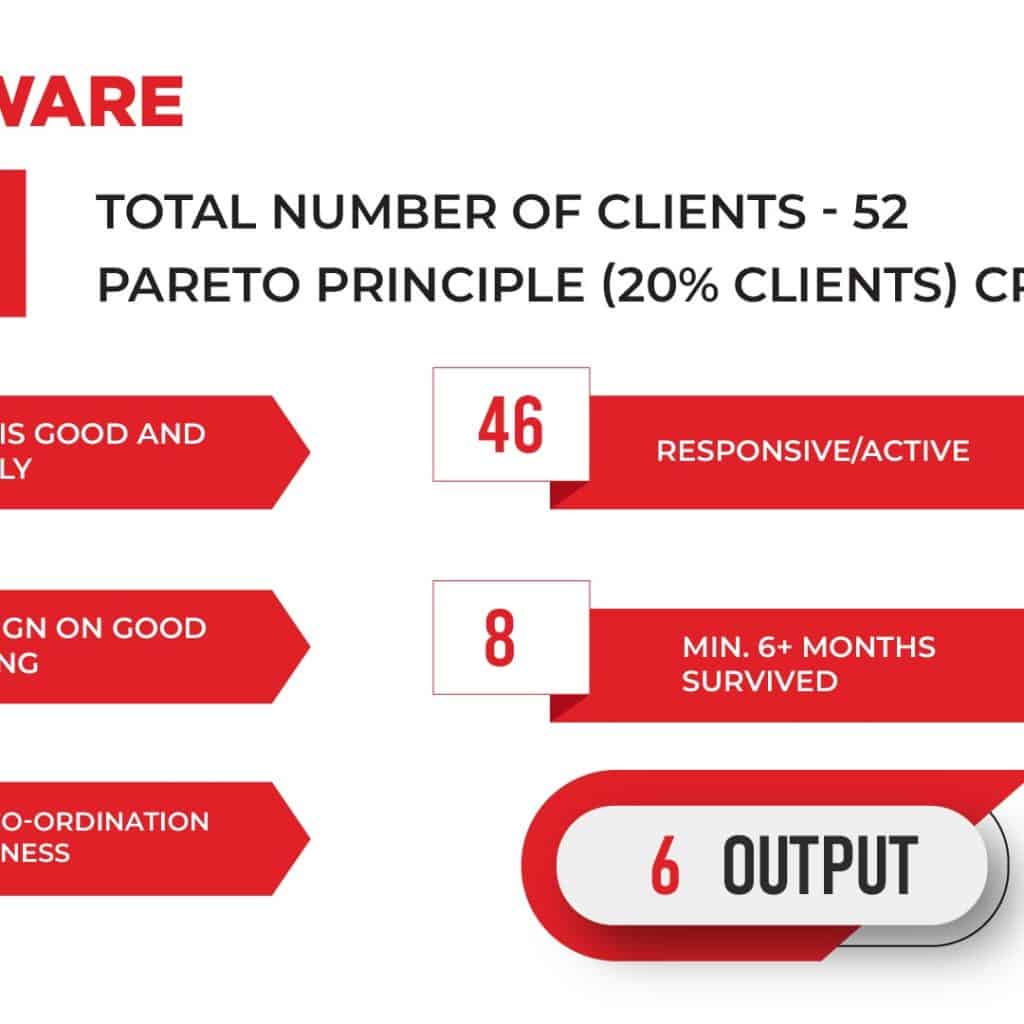
Team 6
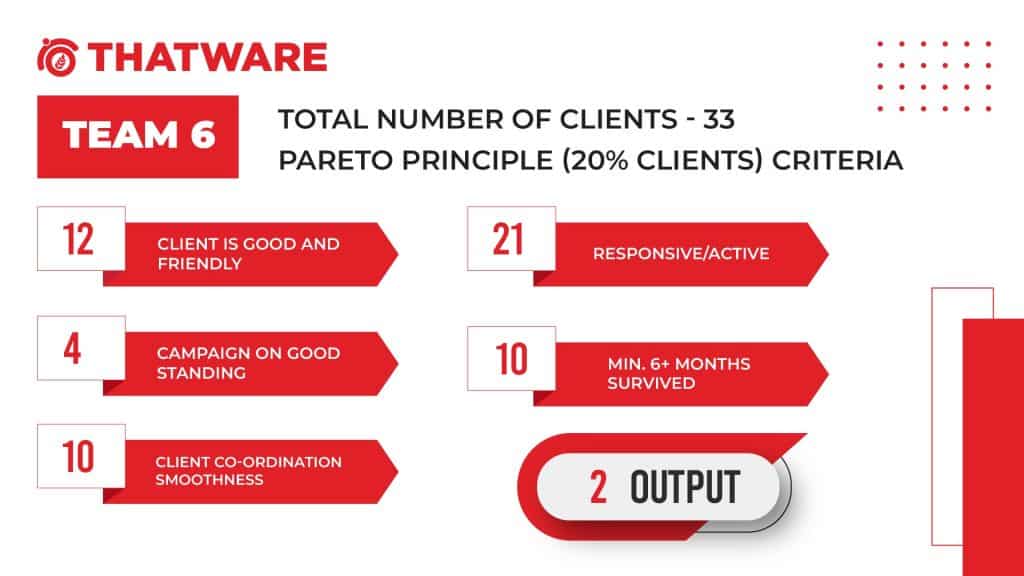
Team 7
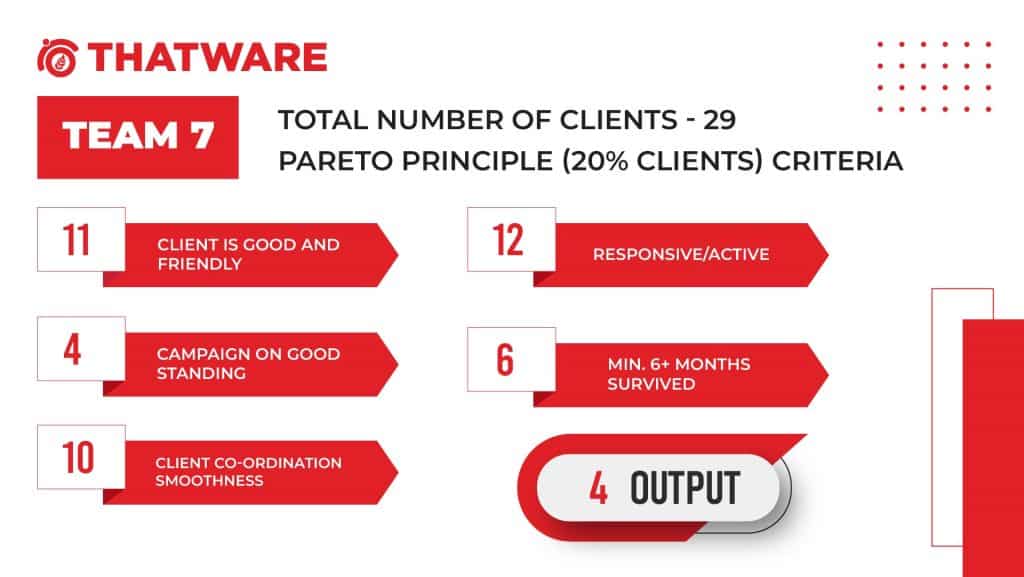
Team 8

Total Output = Output of team 1 + Output of team 2 + Output of team 3 + Output of team 4 + Output of team 5 + Output of team 6 + Output of team 7 + Output of team 8 = 63
Our Parity Principle (20% Clients) depends upon the following criteria –
- Client is good and friendly
As you know, a good and friendly client can immensely boost your morale and help you focus on your work. A simple “Thank You” or a moment of appreciation for the work done can really help motivate the team.
- Responsive/Activeness
Client responsiveness really matters. With the ongoing updates and SEO parameter changes, making some immediate or necessary changes becomes crucial. And our organization values client feedback thus, before amending any changes, we always opt for client feedback and approval. The quicker the approval, the faster the implementation.
- Campaign on good standing
Any campaign with significant traffic growth, clicks, ranking changes, backlink gains, etc reflects our hard-earned efforts showing results. It also denotes that the campaign is running on a steady and prosperous flow.
- Min. 6+ months survived
Having a client surviving the 6 months criteria denotes trust and progress. It shows the client’s determination is dominating the Google SERP and it shows our determination to boost them with the necessary SEO tweaks constantly. This is crucial for us since SEO is all about long-term results.
- Client co-ordination smoothness
Coordination is a two-way path. Just us trying to coordinate while the client is sturdy means failed communication, affecting the workflow. As a result, clients who can be readily co-ordinated and help with other compromises are truly appreciated.
Once I acquire the list of clients that falls under the Pareto Principle, my next aim is to create individualized strategies for each team and help them implement those to generate more impressive results for their respective clients.
Client Relationship: A Vital Component of Success
A good and friendly client relationship forms the foundation of a successful collaboration, especially in service-driven industries like SEO. Working with a client who values communication and appreciates the efforts of the team can significantly enhance the work environment and foster a sense of mutual respect. It’s not just about the work itself but the relationship that is built along the way. When clients acknowledge the hard work through a simple “Thank You” or take a moment to appreciate the progress made, it provides the team with a boost in morale. Positive reinforcement is a powerful motivator, making employees feel valued and encouraging them to work even harder toward achieving client goals.
The Importance of Client Responsiveness
In the ever-evolving world of SEO, where algorithms are continuously updated and new best practices are always emerging, client responsiveness becomes an essential aspect of success. SEO is not a one-time task; it requires regular adjustments to stay on top of the search engine rankings. Many changes, whether technical tweaks, content revisions, or link-building strategies, need to be implemented in real-time to maintain or improve search rankings.
Therefore, a responsive client is one who is willing to engage actively in the process, providing feedback quickly and offering approval for proposed changes. At our organization, we understand the importance of client feedback and ensure that we always seek approval before making any significant adjustments. This collaborative approach ensures that our SEO strategies align with the client’s objectives, avoiding unnecessary back-and-forth and allowing us to implement necessary changes without delays. The quicker the feedback and approval, the faster we can implement the changes, ensuring that the campaign progresses smoothly without missing crucial SEO opportunities.
A responsive client who values timely communication allows the SEO team to address issues swiftly, preventing any potential setbacks. Whether it’s tweaking content to meet new search intent or updating technical aspects of the website, a quick response time leads to faster execution, ultimately resulting in better performance and greater success.
Measuring Success Through Campaign Performance
A successful SEO campaign is one that demonstrates tangible results. This could be reflected through various key metrics, such as traffic growth, click-through rates (CTR), ranking improvements, and backlink acquisitions. Each of these metrics signifies the effectiveness of the SEO strategies in driving positive outcomes for the client.
When an SEO campaign is on good standing, it means that the efforts invested are producing results. If the traffic to the website is increasing, rankings are improving, or the backlinks are growing in number and quality, it means the campaign is moving in the right direction. These results are not just random occurrences; they are a reflection of the collective hard work, dedication, and precision in execution by the SEO team.
A campaign’s success is a culmination of many moving parts. It involves identifying the right target audience, understanding their search behavior, optimizing the content accordingly, and constantly adapting strategies to stay ahead of competitors. Successful campaigns often stand as evidence of the partnership between the agency and the client. The more successful campaigns, the stronger the working relationship becomes, paving the way for long-term business growth for both parties.
The Significance of Longevity: 6+ Months of Client Retention
When a client stays with an SEO service provider for over six months, it symbolizes trust and progress. SEO is a long-term investment that requires ongoing efforts to improve search rankings and maintain competitive positioning. Unlike paid ads that can show immediate results, SEO is about sustaining growth through consistent optimization, which can take months to yield visible results. A client who has survived the 6+ months of SEO services demonstrates patience and understanding of the importance of continuous improvements.
For the SEO agency, it’s a sign of trust. The client believes in the process and is willing to stay on board, even as SEO strategies take time to produce significant results. It also indicates that the client sees value in the agency’s expertise and the quality of work being delivered. This long-term collaboration helps build a deeper understanding of the client’s needs and goals, creating an opportunity for even greater success as both the client and agency grow together.
For the agency, having clients who are willing to stay beyond the six-month mark signals that the efforts put into SEO campaigns are bearing fruit. It also allows the team to refine strategies over time, continually improving the results based on historical data and performance metrics. The more established the relationship, the better the team can tailor SEO solutions to the unique requirements of the client, leading to sustained improvement in organic traffic and rankings.
Smooth Coordination for Effective Collaboration
Client coordination is a critical factor in the success of any project, especially in SEO. Coordination is a two-way street; both the client and the service provider must actively communicate to ensure that objectives are met. A smooth communication channel is the key to making the entire process more efficient. Without it, misunderstandings or delays can occur, which could impact the overall timeline and results.
Clients who are easy to coordinate with, who respond promptly to emails, attend meetings, and collaborate on adjustments, significantly enhance the workflow. Clear communication allows the SEO team to understand the client’s vision and goals, while also ensuring that the client is fully informed about the process, expectations, and ongoing changes. Furthermore, a client who is flexible and willing to compromise when necessary can make the SEO optimization process much smoother.
SEO campaigns are dynamic and often require mid-course adjustments based on data analysis, changing trends, or unexpected developments. Clients who are open to collaborating on these adjustments help optimize the process and improve results. For instance, if a strategy needs fine-tuning due to shifting market trends, an easy-going client who is receptive to new ideas makes the task of adapting the strategy much more efficient. This smooth coordination results in a more fruitful partnership and increased chances of campaign success.
The Pareto Principle: Identifying High-Value Clients
The Pareto Principle, or the 80/20 rule, suggests that 80% of outcomes stem from 20% of efforts. In the context of client relationships, identifying those clients who bring the most significant results and revenue to the agency is vital. These clients tend to be loyal, actively engage with the process, and appreciate the agency’s expertise. By identifying these high-value clients, SEO teams can focus more attention on ensuring their success, leading to better outcomes for both the agency and the client.The next step, once high-value clients are identified, is to develop individualized strategies for each one. Every client is unique, and their goals and challenges will vary. Creating tailored SEO strategies based on their specific needs, target audience, and industry will help generate more impressive results. By leveraging data-driven insights, SEO teams can refine their strategies to align more closely with the client’s objectives, leading to faster results and greater satisfaction.
Individual Customized Strategy
Each of the TL’s from their respective team comes up with individualized strategies that can help them in providing more impressive results for their respective clients. The strategies are discussed individually between me, the respective TL and the managers. Once approved, the strategies are sent to the client to ask for their approval and feedback.
Here’s the list of Individual customized Strategies offered by the respective teams –
Team 1:
- Internal Linking Suggestion
- Internal Linking Implementation
- Heading & Child Heading Tags Inspection
- Heading & Child Heading Tags Implementation
- Cannibalisation Checkup
- Canonical Issues Checkup & Fixes
- Brand Anchor Text Linking
- NAP Audits
- Link Acquisition with Brand Statement
- Link Intersect Outreach
- Descriptive ALT Text Suggestion for Images
- Product Markup Suggestion for Google Image Search
- Standard Video Rich Results Testing
- YouTube Channel Upgrade Suggestion
- Semantic SEO Module Implementation (AI)
- HARO Outreach
- Paginated Results Checkup in SERP & Fixes
- Latest Algorithm Checks
- Google Search Console Inspection & Fixes
Team 2:
- 404 Page Check
- 404 Page Error Fixes
- Above the Fold Optimization
- Brand Anchor Text Optimization
- NAP Building
- Gap Based Links
- Passage Indexing Optimization
- Unlinked Brand Mention
- GSC checks & fixes
- Latest Algorithm Checks
- Image SEO (Image filename checkup and improvement suggestion)
- Video SEO (Video links optimization)
- Existing blog optimization
- HARO Outreach
Team 3:
- YouTube Video Title Optimization
- YouTube Video Description Optimization
- YouTube Channel Videos Tag Optimization
- YouTube Channel Optimization
- Unlinked Brand Mention
- GSC checks & fixes
- Latest Algorithm Checks
- HARO Outreach
- Image SEO (Image alt checkup and alt tag fixing)
- Video SEO (Video url suggestion & optimization)
- Existing blog optimization (keyword density checks)
Team 4:
- Unlinked Brand Mention
- GSC checks & fixes
- Latest Algorithm Checks
- Image SEO (Image alt checkup and alt tag fixing)
- Video SEO (Video url suggestion & optimization)
- Content Audit for the Priority Product Pages
- Content Optimization for Top Landing pages according to traffic
- Header hierarchy setup and implementation
- Indexing Analysis
- HARO Outreach
- Thin Content Identification
- Blog promotion for gaining traffic
Team 5:
- Correct distribution of links to different pages
- GSC checks & fixes
- Latest Algorithm Checks
- Image SEO (image rendering checks)
- Video SEO (Video text suggestion)
- Backlink count inspection for top landing pages
- Broken link checks & fixes
- Redirection issues checks & fixes
- GMB Audit
- HARO Outreach
- Link Acquisition with a brand statement
Team 6:
- Toxic Links Checkup
- Toxic Links Disavowal
- Spam Monitoring
- GSC checks & fixes
- Latest Algorithm Checks
- Image SEO (image dimension checks)
- Video SEO (video ratio checks)
- Link Intersect
- Semantic SEO Module Implementation
- GMB Optimization
- ORM
- HARO Outreach
Team 7:
- Hreflang optimization
- GEO tag checkup & optimization
- Backlinks status check & monitoring
- Lost backlink recovery by creating new backlinks
- GSC checks & fixes
- Latest Algorithm Checks
- Image SEO (image dimension checks)
- Video SEO (video ratio checks)
- Link Intersect
- Semantic SEO Module Implementation
- GMB Optimization
- ORM
- HARO Outreach
Team 8:
- Soft 404 errors checks
- Soft 404 errors fixes
- Crawl Budget Optimization
- GSC checks & fixes
- Latest Algorithm Checks
- Image SEO
- Video SEO
- Competitor Based Links
- HARO Outreach
- AI SEO Module Implementation
- GMB Product Posting
- GMB Image Posting
- GMB Video Posting
Meeting Arrangement
The monthly meeting is something which is of utmost importance for both the clients and us. Basically, the meeting arrangement is where we have in-depth discussions with the clients regarding the current status of their website, the areas of improvement, how to proceed with a strategic plan of action over the next month, the pricing plans for certain services that we offer and so on.
We discuss some of the advanced strategies that will be implemented moving forward with the campaign and the designated results they will offer.
In a nutshell –
- Step 1: We first ask our clients regarding their availability for a meeting
- Step 2: We create a meeting calendar for the upcoming scheduled meetings
- Step 3: We share the meeting calendar with the clients
- Step 4: We proceed with the meeting on the designated date
One thing to note, as the campaign proceeds forward, the criteria for the meeting change accordingly.
The initial meeting strategies during client onboarding to the first couple of months revolve around maximum technical fixes, GA-GSC setups, goal tracking, low-hanging fruit fixes and so on.
As the project lies in its gestation period (2-4 months), the focus of the meeting revolves around some technical fixes, on-page blogging, link building and so on.
Once the project has reached its maturity period (6 months+), the meeting focuses on improved content strategy, advanced link-building strategies, social media postings and more.
Client Pitch
The client pitching varies depending upon the client’s needs. According to their needs, we dispose of an extra workforce who tend to implement additional SEO strategies based on additional budget.
The pitching is mainly done when the client needs growth on a certain aspect on a faster scale,
For example – the client asks for 3x traffic growth in a month or 5x rank push in a month,
We pitch them with additional advanced strategies like extensive competitor analysis and blogger outreach, paid ads campaigns, social media, etc. In turn, each additional service will come under a specific package with an extra add-on budget.
Conversion
This is one of the most important aspects for us. Here is a quick example to better understand the conversion rate –
- Suppose you have 10 Teams
- Each team constitutes an average of 5 clients/team
- Your total clients sums up to = 5 * 10 = 50 clients
- Now following the Pareto Principle,
- Number of client * 20% = 50 * 20% = 10 clients
- Let’s now consider that each of these 10 clients offer $500/client,
- Then our total conversion at the end of one month sums up to = 10*500 = $5000.
- Now moving forwards, if we are able to stick up with these 10 clients for a duration of 12 months,
- Then the total amount generated yearly = 5000*12 = $60,000
Meeting Arrangement: A Vital Component of Client Success
Monthly meetings are a cornerstone of successful client relationships in the digital marketing and SEO industry. They provide an invaluable opportunity for clients and the SEO agency to engage in detailed, in-depth discussions about the current status of the client’s website, address concerns, make adjustments, and strategize for the future. These meetings are where the campaign’s effectiveness is analyzed, and new objectives are set to ensure that the project continues to deliver optimal results.
The primary objective of the meeting is to evaluate the progress of the SEO campaign, understand the areas of improvement, and develop a plan of action for the upcoming months. These discussions may revolve around anything from site traffic analysis to pinpointing technical issues or refining content strategies. Additionally, the meetings offer a platform for the agency to explain the pricing structure for various services and the corresponding benefits that these services provide.
The meeting arrangement process follows a structured approach to ensure that the client’s needs are always prioritized:
- Step 1: The process begins by asking clients for their availability for a meeting. Scheduling is key, and ensuring that both parties can meet at a convenient time helps to maintain regular communication without unnecessary delays.
- Step 2: Once the availability is confirmed, a meeting calendar is created for all scheduled meetings. This ensures that everyone stays organized, and there are no scheduling conflicts or miscommunications.
- Step 3: The meeting calendar is shared with clients ahead of time, allowing them to review the dates and prepare any questions, concerns, or ideas they wish to discuss during the meeting.
- Step 4: Finally, the meeting takes place on the designated date, and the agenda is discussed thoroughly, including performance metrics, potential improvements, and upcoming strategies.
The focus and criteria for these meetings evolve as the SEO campaign progresses. Early meetings during the client onboarding phase focus primarily on technical fixes, setting up analytics tools like Google Analytics (GA) and Google Search Console (GSC), goal tracking, and making initial optimizations. These meetings are essential in ensuring that the foundation of the SEO campaign is solid before moving on to more advanced strategies.
In the next phase, which typically spans from two to four months, the meeting shifts its focus. The agenda includes reviewing technical issues that still need attention, refining on-page optimization, focusing on blogging and content creation, and beginning efforts for link building. By this time, initial improvements should be visible, and clients will start to see the benefits of the early SEO work.
As the campaign matures, usually around the six-month mark and beyond, the scope of the meeting changes to reflect the campaign’s evolution. The focus now moves to more advanced content strategies, in-depth link-building techniques, and integrating social media efforts to boost engagement and further support SEO goals. The meeting discussions at this stage center on analyzing the long-term results and identifying new opportunities for sustained growth.
Client Pitch: Tailored Strategies for Rapid Growth
Client pitching is a crucial aspect of an SEO service provider’s role, particularly when clients seek accelerated results. This phase involves crafting specialized strategies designed to address specific needs or goals within a set timeframe. For example, when clients require significant traffic growth within a short period or need an aggressive rank push, the agency must be ready with tailored solutions that can help them achieve these ambitious goals.
The pitch typically revolves around providing additional workforce or resources to implement more aggressive SEO strategies that go beyond the standard approach. This may include more intensive competitor analysis, leveraging blogger outreach for content promotion, running paid ads campaigns, and increasing social media activity to drive more traffic and engagement. These services, however, come at an additional cost, and the client must be willing to commit to an updated package with a higher budget to support these efforts.
The goal of the pitch is to highlight the specific services that can rapidly move the needle in terms of performance. For instance, if a client requests a 3x increase in traffic within a month or 5x rank improvement, the SEO agency must show how they can achieve this through additional services that go beyond the standard SEO practices. These services typically come with their own set of expectations and timelines, and the client must understand that the results will require a more significant investment.
The additional services offered can be customized to the client’s needs, and each service will be priced accordingly. This tailored pitching approach ensures that the client can make an informed decision, understanding both the benefits and the costs associated with accelerated SEO growth.
Conversion: Turning Leads into Long-Term Revenue
The process of conversion is critical in SEO businesses because it directly impacts the profitability and growth of the company. Conversion rate refers to the ability of an agency to turn leads or potential clients into paying clients and ultimately retain them for a long period. The more successful conversions an agency achieves, the greater its revenue potential.
Consider the example of a company that manages 10 teams, each with 5 clients per team, resulting in a total of 50 clients. According to the Pareto Principle—which suggests that 80% of results come from 20% of efforts—only 20% of the clients contribute to the bulk of the revenue. In this case, 20% of 50 clients equals 10 high-value clients.
If each of these 10 clients contributes an average of $500 per month, the total monthly revenue from these clients will be $5,000. The real power of conversion comes when these clients stay with the agency for an extended period. Let’s assume that these 10 clients remain with the agency for 12 months. In that case, the total annual revenue generated from these clients would amount to $60,000. This revenue can increase even further if the agency successfully retains more clients or upsells additional services.
By focusing on high-value clients and maintaining their trust over the long term, SEO agencies can create a sustainable and growing revenue model. The key to high conversion rates lies in providing excellent service, meeting client expectations, and continuously optimizing SEO strategies to deliver measurable results. Additionally, client retention is just as important as conversion. Clients who stay with the agency for the long term provide a consistent revenue stream and an opportunity to build stronger, more meaningful relationships.
Conclusion
As you can see, 1 simple strategy change can do you wonders. What you need is a bit of creativity, an innovative approach and a sound knowledge of various marketing terminologies. In order to boost your business, you should always be in the driver’s seat and keep up with the latest trends in the marketing industry. Trust me, Pareto Principle has done wonders for me! And not, it’s your turn to use this method and do wonders for your business.

Thatware | Founder & CEO
Tuhin is recognized across the globe for his vision to revolutionize digital transformation industry with the help of cutting-edge technology. He won bronze for India at the Stevie Awards USA as well as winning the India Business Awards, India Technology Award, Top 100 influential tech leaders from Analytics Insights, Clutch Global Front runner in digital marketing, founder of the fastest growing company in Asia by The CEO Magazine and is a TEDx speaker and BrightonSEO speaker.

